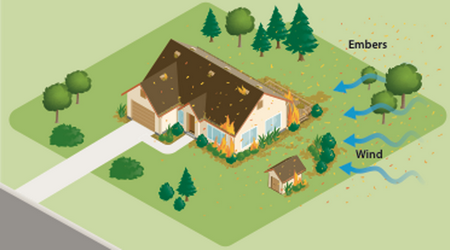From the UC Blogosphere...
Home Landscaping for Fire Safety
Living with the threat of wildfire is an unfortunate fact of life for Californians. While we cannot control wildfire, we can help minimize its destruction by practicing fire safe strategies which harden the landscape by reducing the vulnerability of your home and property to wildfire.
In recent years, we have seen many fires that have affected homes that are not even close to an open space. A single spark which is called a firebrand or flying ember can travel miles in the wind making us all vulnerable.
Hardening the landscape
Creating a beautiful and functional landscape as well as a fire adapted property can be accomplished using the concept of Defensible Zones. Your property can be viewed as 3 defensible zones and when done properly, it makes your home and property less prone to fire. In these zones, we look for places to prevent ignition, slow fire down, and improve firefighter access.
The Zones are:
Zone 0: Ignition Zone
0-5 feet from home.
Zone 1: Firebreak Zone
5-30 feet from home.
Zone 2: Reduced Fuel Zone
30-100 feet from home or to your property line.
Zone 0: Ignition Zone: 0–5 feet
This zone is the most important one. The first 5 feet from your home are critical to the safety of your home and family. Those 5 feet should be clear of anything that will burn. This includes plants, shrubs, overhanging trees, and mulch. Remove all flammable hazards that are within this critical zone including stacks of wood, propane tanks, wooden chairs, benches, dead vegetation, leaves or cobwebs under the eaves or in rain gutters, and wooden fences. It is important to eliminate any material that could be ignited by a flying ember. Also make sure to remove tree branches that overhang the roof.
Zone 1: Firebreak Zone: 5–30 feet
In this zone, the primary goal is to stop a fire from spreading. We want to use space (separation) to create areas that “break” or slow the path of any fire. Hedges and wooden fences are of special concern, as they can channel flames toward the house. Strategically created space between shrubs, trees, plants, and anything else that might burn will create a fuel break that will make it harder for flames to spread on the ground from plant to plant and to your home. Prune and thin, remove plants and separate layers of vegetation, for example by removing lower tree branches, so that a fire cannot “ladder”, or climb up shrubs to trees to your home/roof. Incorporate fire-safe hardscape materials throughout this area like stone, gravel, cement, metal fences, water features and pathways.
Zone 2: Reduced Fuel Zone 30–100 feet
We want to REDUCE THE FUEL in this zone all the way around your home. Fuel is anything that will burn including dead vegetation, downed branches, overgrown areas, low hanging trees, flammable plants and wooden fencing. Keeping this area clear of dead material and adding hardscape will eliminate fuel and help stop fire from spreading across your property. It will also help improve firefighter access to your property.
For more information on defensible space:
https://ucanr.edu/sites/fire/Preparedness/Landscaping/DefensibleSpace/
How to Start: Develop a Strategy for each zone
• Identify problem areas
• Minimize slope risk
• Target plants for removal
• Add plants that are fire resistant
• Plant in an island format
• Make liberal use of hardscaping (rocks, cement, gravel, rock walls, boulders, etc.)
• Include irrigation to keep plants and trees from becoming unsafe
Slope:
In a hilly area, fire will travel faster and flames will shoot higher, therefore it is important to add 10 feet of additional space between trees for every 10% increase in slope. This additional space can help keep the fire from laddering from tree to tree up the hill.
Use Fire Resistant Plants:
The most important thing is to plant the right plant in the right place. This maxim is true for growing conditions and also for fire safety. Remember that all plants can burn so placement is the most important factor. Fire resistant plants share the following characteristics:
Leaves: High moisture content, fleshy and large or coarse like you see in succulents and cactus.
Trees: Deciduous: their thin moist leaves shrivel up when there is fire or extreme heat so don't help ladder into the canopy. Also look for trees and shrubs that have an open and airy structure, allowing for more air circulation and are less likely to harbor dead organic material at the center. Drought tolerant or native to California are the best options.
Remove Flammable Plants and Weeds
Here are good clues for identifying Fire PRONE plants:
Leaves: low moisture content/dry, small, fine or needle like cypress and juniper
Oils: Aromatic, resinous like rosemary and eucalyptus. Decorative hedges and large plants, such as bamboo and conifers including cedars and firs.
Trees: plants that produce a lot of debris increase fire danger. Eucalyptus trees have bark that is loose or papery which creates a lot of debris making these trees very dangerous.
Weeds: All weeds that are higher than 3” are highly flammable and need to be removed.
For more information on fire safe planting: https://ucanr.edu/sites/fire/Preparedness/Landscaping/Plant_choice/
Mulch:
Mulch plays an important role in your landscapes. Besides looking great it provides many benefits:
• water retention,
• soil temperature control
• weed inhibition
• helps prevent soil erosion
BUT…mulch can be highly combustible material in your landscape. The bigger and heavier the pieces the better. But remember it all burns. It is important NOT to have any flammable mulch within 5 feet of your house and other structures.
See more mulch information about mulch and flammability at this link:
https://ucanr.edu/sites/fire/Preparedness/Landscaping/Mulch/
Maintenance: The final element in a fire safe landscape
Be diligent in your maintenance habits in order to keep your property firesafe as follows:
Ongoing:
• Remove weeds, dead plants, leaves and branches.
• Remove vines from trees and fences.
• Compost or remove all debris.
Annually:
• Thin vegetation and cut weeds to 3.”
• Cut back woody plants.
• Ensure sufficient space between shrubs, house and trees.
Every few years:
• Cut back vines, groundcovers.
• Prune tree branches to 10' above ground and above roof.
See more information on maintenance here: https://ucanr.edu/sites/fire/Preparedness/Landscaping/Trees/
Community resources: Firewise: National Fire Protection Association
Firewise is a nationally recognized program for bringing homeowners together to improve the safety of the neighborhood. They offer guidelines, training, and certification.
More information on Firewise here:
https://www.nfpa.org/Education-and-Research/Wildfire/Firewise-USA
In addition to landscaping for fire safety, it is critical that you think about how you can make your home and other structures on your property less susceptible to fire. This is a good chart/source for things to think about:
https://ucanr.edu/sites/hdnmastergardeners/files/357133.pdf
Help Desk of the UC Master Gardeners of Contra Costa County (PDS)
Forecast of Heavy Rain, Wind Changes Location of California Honey Festival
Despite the weather forecast of heavy rain and wind, honey bees will still be "attending" the California Honey...

The California Honey Festival will include bee observation hives. (Photo by Kathy Keatley Garvey)
Clement Chow: Fruit Flies, Rare Diseases and the Accomplishments
Don't miss the UC Davis Department of Entomology and Nematology seminar by Clement Chow on Monday, May 6. It will...
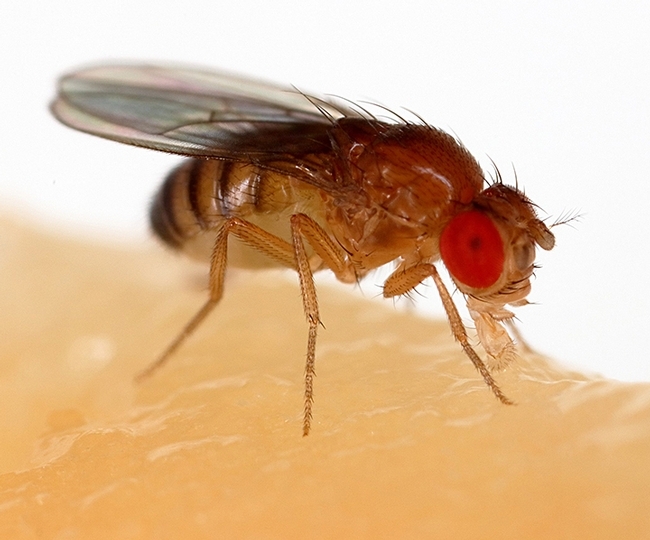
The fruit fly, Drosophila melanogaster, is commonly used for biological research in genetics. (Photo courtesy of Wikpedia)
California Dogface Butterfly Steals the Show
The California dogface butterfly stole the show at the Bohart Museum of Entomology pop-up tent at...
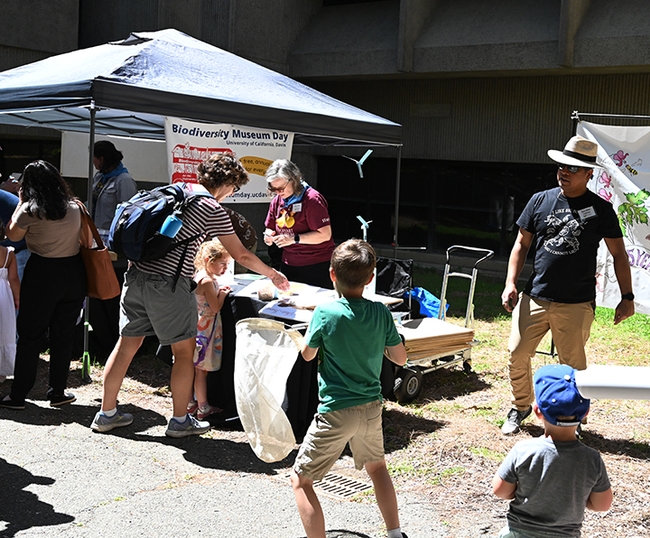
Bohart Museum graduate student and researcher Socrates Letana tosses paper butterflies to the net holders, as Professor Fran Keller (background) of Folsom Lake College staffs the California butterfly table. (Photo by Kathy Keatley Garvey)
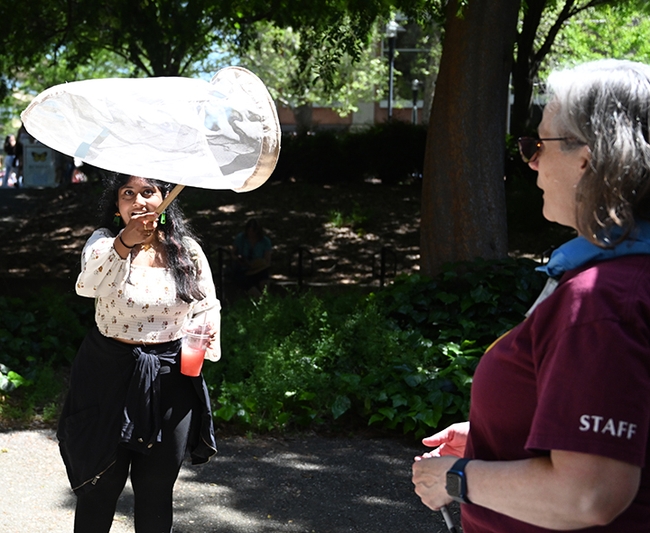
It's a catch! UC Davis undergraduate student Lasya Nalia, majoring in environmental horticulture, nets a paper butterfly tossed by Professor Fran Keller of Folsom Lake College, a Bohart Museum scientist and UC Davis doctoral alumna. (Photo by Kathy Keatley Garvey)
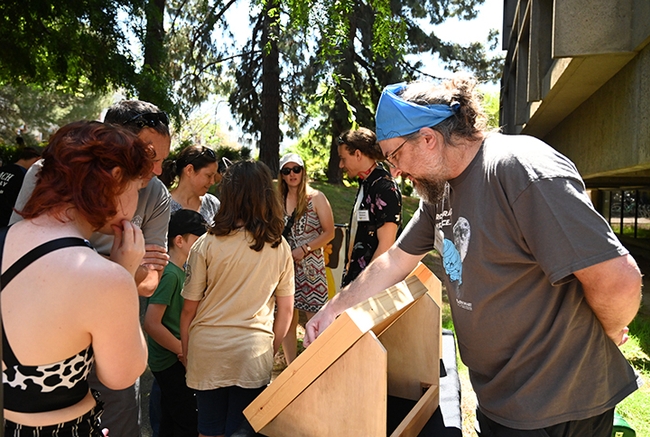
Postdoctoral researcher and arachnologist James Starrett (foreground) and doctoral student and dragonfly expert Christofer Brothers (background) talk to visitors about the insect specimens. (Photo by Kathy Keatley Garvey)

Professor Fran Keller of Folsom Lake College poses with a California dogface butterfly face banner. She is a UC Davis doctoral alumna and a Bohart Museum scientist. (Photo by Kathy Keatley Garvey)
A Special Day for UC Davis Distinguished Professor Walter Leal
Today (April 30) was a special day for entomologist Walter Soares Leal. “I got two phone calls almost...

UC Davis distinguished professor Walter Leal today (April 30, 2024) was named a member of the National Academy of Sciences. (Photo by Kathy Keatley Garvey)



